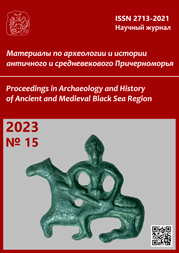Удила сарматских типов в пьяноборской культуре
Bridles of the Sarmatian types in the Pianyi Bor Culture
Author(s): A.A. KrasnoperovSubject(s): Archaeology
Published by: Нижневартовский государственный университет
Keywords: the Kama River; the Sura River; middle Sarmatian time; bridle; cheek-pieces; typology; chronology; the Andreevka—Piseraly site type; the Pianyi Bor Culture;
Summary/Abstract: The subject of the publication is a group of horse bits with the rod-shaped cheek-pieces equipped with a pair of rectangular frames of fixing the headstall straps. The conventional dates of the two-looped cheek-pieces seem to fit the interval from the first half of the 1st century BCE up to the first half of the 2nd century CE. Bridle finds from the Sarmatian area and the forest zone are discussed. Accompanying finds are regularly repeated, but chronologically not uniform. One chronological group is associated with a complex of ‘oriental innovations’ in the Sarmatian culture, which provides a fairly long interval of dates within the 2nd — 1st centuries BCE, but not narrow dates thereof. Another chronological group is associated with various buckles as well as Almgren-87 and Almgren-156 fibulae. Sarmatian bridle forms became widespread on the periphery of the Sarmatian world, wherein two areas of concentration of finds can be distinguished along the Sura and the Kama Rivers. Considering accompanying grave inventories, interactions between the ‘Pianyi Bor’ and ‘Andreevka—Piseraly’ (АР) groups seem to be the most probable; the cheek-pieces of the Sarmatian types could only get to the latter as a result of interaction with the Sarmatian groups. The AP groups must have acted as intermediaries in the process of distribution in the forest zone. The contacts were reciprocal, west and east and vice versa, yet the starting position was occupied precisely by the AP groups, since it is these sites which contain the most complete set of elements in recurring archaeological contexts. In the cemeteries of Pianyi Bor, these elements, though quite frequent, are nonetheless scattered and isolated.
Journal: Материалы по археологии и истории античного и средневекового Причерноморья
- Issue Year: 2023
- Issue No: 15
- Page Range: 142-167
- Page Count: 26
- Language: Russian

